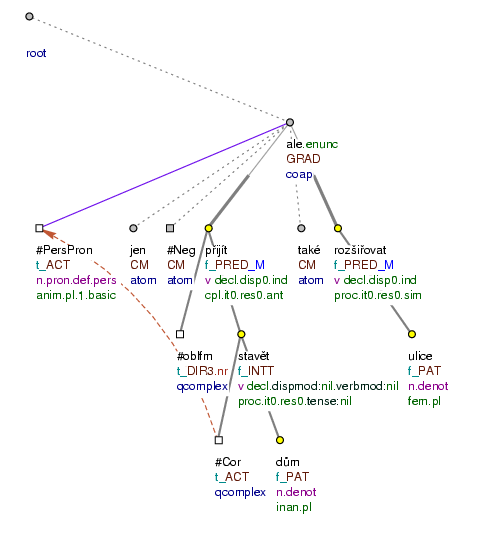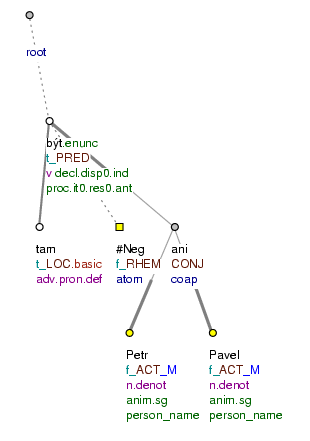Negating expressions may also act as conjunction modifiers (see Section 16.1.2, "Conjunction modifiers"). Both the negating particles (ne (=no /not), nikoli (=by no means / not), nikoliv (=by no means / not)) and the negating morpheme ne- (=non- / un-) (t_lemma=#Neg) can be conjunction modifiers.
A negating expression is a conjunction modifier in such paratactic connections in which the connective can be used only when one of the constituents of the paratactic connection has a negative form. Cf.:
-
Nepřišel Karel, ale Pavel. (=It was not Charles who came, but Paul.)
-
Přišel Karel, ale ne Pavel. (=Charles came, but not Paul.)
-
But one cannot say: *Přišel Karel, ale Pavel. (=*Charles came, but Paul.)
It is usually a case of an adversative paratactic connection (functor ADVS), but it may also be a negative variant of a comparative relation (GRAD) or a disjunctive relation (DISJ); for example:
Nepřišel jen Karel, ale.GRAD i Pavel. (=Not only Charles came, but Paul as well.)
The node representing a negating expression in the function of a conjunction modifier has the functor CM and is represented according to the rules in Section 16.1, "Co-ordinating connectives".
The boundary between the rhematizer and the conjunction modifier in negating expressions. A negating expression coocurring at surface level with a constituent coordination (usually adversative) is evaluated as a conjunction modifier. A constituent coordination acts in terms of functional sentence perspective as a unit (see Section 4.3.2.1, "Topic-focus articulation of paratactically connected dependent modifications and clauses"), so that a boundary between the topic and the focus cannot pass through it, and the negating expression (particle or morpheme) does not signal the focus (does not have a rhematizing function), but merely modifies the paratactic connection. Cf.:
-
Bude mít velký dům, ale.
ADVSne.CMnové auto. (=He / she will have a large house but not a new car.)Constituent co-ordination. The negating particle will be represented as a conjunction modifier. Cf. Fig. 8.283.
-
{
#Neg.CM} Nepřišel Jirka, ale.ADVSKarel. (=It was not George who came, but Charles.)Constituent co-ordination. The negating morpheme will be represented as a conjunction modifier.
-
Z politiky jsem si přinesla fakta, ne.
CMteorie. {#Comma.ADVS} (=Politics gave me facts, not theories.)Constituent co-ordination. The negating particle will be represented as a conjunction modifier (here, it modifies the comma).
Further examples:
{#Neg.CM} Nekoupil chleba, ale.ADVS máslo. (=He did not buy bread, but butter.)
Koupil chleba, ale.ADVS ne.CM máslo. (=He bought bread, but not butter.)
{#Neg.CM} Vlak neodjel ve čtyři hodiny, ale.ADVS v pět. (=The train departed not at four o'clock but at five.)
{#Neg.CM} Chruščov nebyl pohřben u kremelské zdi, ale.ADVS zde. (=Khrushchov was not buried by the walls of the Kremlin but here.)
{#Neg.CM} Nejde o sobotu, ale.ADVS o neděli. (=It does not mean Saturday but Sunday.)
Přijel do Prahy, nikoli.CM do Brna. (=He came to Prague and not to Brno.)
In clausal co-ordination, a negation becomes a conjunction modifier only in cases where the expressions nejen (=not only), nejenom (=not only) are divided into a negating expression and a restrictor jen (=only), jenom (=only), pouze (=only). In other cases of clausal co-ordination the scope of negation in individual sentences may vary (here, negation has a rhematizing function). Cf:
-
{
#Neg.CM} Nepřišli jsme jen.CMstavět domy, ale.GRADtaké.CMbudeme rozšiřovat ulice. (=We have not come just to build houses but we will also widen the streets.)Clausal co-ordination. The negating morpheme will be represented as a conjunction modifier; here we have the separation of the expression nejen (=not only) into a negating morpheme and a restrictor jen (=only). Cf. Fig. 8.284.
-
{
#Neg.CM} Nepřišel jen.CMKarel, ale.GRADpřišel i Pavel. (=Not only Charles came but Paul came as well.)Clausal co-ordination. The negating morpheme will be represented a conjunction modifier; here we have separation of the expression nejen (=not only) into a negating morpheme and a restrictor jen (=only).
-
{
#Neg.CM} Naším zájmem není jen.CMstavět domy, ale.GRADtaké.CMzřizovat dětská hřiště. (=Our concern is not only to build houses but also to set up children's playgrounds.)Clausal co-ordination (between the infinitives stavět (=to build) and zřizovat (=to set up)). The negating morpheme will be represented a conjunction modifier; here we have separation of the expression nejen (=not only) into a negating morpheme and a restrictor jen (=only).
Figure 8.283. The negating particle as a conjunction modifier

Bude mít velký dům, ale ne nové auto. (=lit. (He/she) will_have (a) large house, but not (a) new car.)
Figure 8.284. The negating morpheme as a conjunction modifier

Nepřišli jsme jen stavět domy, ale také budeme rozšiřovat ulice. (=lit. (We) have_not_come AUX only to_build houses but also we_will widen (the) streets.)
NB! In the case of constituent co-ordination with the conjunction ani (=neither/ nor) negation is demanded by both co-ordinated elements - two elements are conjoined which are both negated - here, the negating morpheme has a rhematizing function. The node representing syntactic negation (t_lemma=#Neg) is the left sister of the root of the co-ordinated structure and it has the functor RHEM. The entire coordination is then within the scope of the rhematizer. (For detailed rules see Section 6.4.1, "Rhematizers in paratactic structures"). Cf.:
-
{
#Neg.RHEM} Nebyl tam Petr ani.CONJPavel. (=Peter was not there, nor was Paul.)Constituent co-ordination (simple conjunction, with the conjunction ani (=nor / neither)). The negating morpheme will be represented as a rhematizer whose scope is the entire constituent coordination. Cf. Fig. 8.285.
